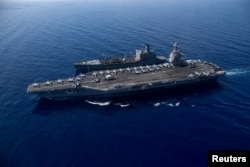Documents show that a U.S. research program is making progress on its goal to use a safer kind of fuel for nuclear-powered Navy submarines and military ships. But the program’s governmental financial support is at risk.
The aim of the research is to change from using highly-enriched uranium, which can be used to make bombs, to a safer choice.
Since 2018, the U.S. government has been exploring how to use low-enriched fuel that cannot be used as an explosive in weapons. It is doing this to help decrease the proliferation risks of keeping stores of highly-enriched uranium.
Proliferation means a fast increase in the amount of something. Nuclear proliferation is the spread of nuclear weapons or materials that can be used to make nuclear weapons.
The National Nuclear Security Administration (NNSA) sent a report to the U.S. Congress last year. It said the research program progressed from a planning stage to an experimental campaign stage during the 2021 fiscal year. It added that early findings represent progress in what could be a 20- to 25-year design effort.
The documents were recently seen by Reuters reporters.
The issue of highly-enriched uranium is critical because of a defense technology partnership between the U.S., Australia and Britain. The $245-billion partnership, called AUKUS, permits the sale of U.S. nuclear-powered submarines. It also permits the sharing of nuclear-propulsion technology with Australia. The partnership is in answer to China’s growing power in the Indo-Pacific.
Non-proliferation experts say sending submarines to Australia that use highly-enriched uranium could lead to other countries using the fuel.
The NNSA document said the low-enriched uranium fuel program seeks to meet certain U.S. Navy requirements. The document added that the fuel development process would be long and costly. Success, it said, is not guaranteed.
The document also noted a 2016 report’s findings that it could cost more than $1 billion to develop alternative fuel. That report also said low-enriched fuel would hurt reactor strength, ship costs and operational effectiveness.
The NNSA’s 2022 report warned the costs could take away from the higher aim of non-proliferation and naval propulsion research and development.
Still, head of the NNSA Jill Hruby said in the document she was pleased with progress the program has made in this difficult effort.
NNSA did not immediately respond to questions about the documents when asked by Reuters.
Congress has given the program $100 million since 2016. But governmental financial support is in question after a group in the Republican-controlled House of Representatives this year voted to stop it. The Senate has approved financial support and the Senate and House of Representatives are expected to work together to decide on any funding.
Alan Kuperman is a professor at the University of Texas at Austin. He works at the Nuclear Proliferation Prevention Project. He has pushed the government to accept low-enriched uranium for Navy ships.
Kuperman also looked at the documents from NNSA. He said the documents make three things clear. First, the program is very important in preventing the spread of nuclear weapons. Second, it is making quick progress. And third, it will go into use only if it can keep the current performance of U.S. Navy ships.
He said the possible $1-billion cost for the fuel was small compared to trillions of dollars spent on all the Navy’s nuclear ships.
I’m Gregory Stachel.
Timothy Gardner reported this story for Reuters. Gregory Stachel adapted it for VOA Learning English.
_________________________________________________
Words in This Story
enrich – v. to improve the quality of (something)
fiscal – adj. of or relating to money and especially to the money a government, business, or organization earns, spends, and owes
propulsion – n. the force that moves something forward
alternative – adj. not usual or traditional
reactor – n. a large device that produces nuclear energy
fund – v. to provide money for (something)










Forum